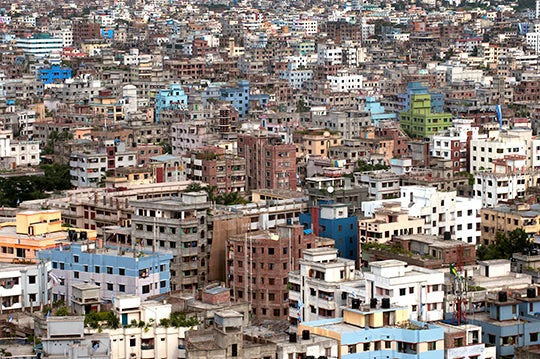Bangladesh, the most vulnerable country in the world to the impact of natural disasters is also a leader in emergency preparedness and disaster response, particularly for cyclones, tidal surges and floods. This was achieved through 25 years of effort, which was catalyzed through two devastating cyclones, one in 1970 and 1991 that caused the deaths of approximately 500,000 and 300,000 people respectively. Part of what makes Bangladesh so strong at cyclone preparedness and response is the fact that major cyclones seem to hit Bangladesh every 3-4 years. Recurrence of this frequency is quite unique.
On the other hand, major seismic events that lead to major losses occur infrequently. Cities like Dhaka and Kathmandu, which are susceptible to major earthquakes, haven’t experienced a major shake in more than a generation. Unfortunately, a lack of frequency often leads to complacency amongst governments and citizens. Even more problematic is the very rapid accumulation of assets and population in urban environments in South Asia, including Dhaka.
Walking through the streets of Dhaka paints a picture of a city with significant structural vulnerabilities – where poor construction standards, lack of enforcement, and poor maintenance turn many buildings into potential hazards. When a building in Savar collapsed in April 2013 – killing over 1,100 people and injuring thousands more – it was a wakeup call for Bangladesh. The collapse was not triggered by an earthquake, it was the result of catastrophic structural failures, but it was a glimpse into what could happen in the event of a major earthquake.
Dhaka has been identified by Stanford University, the leading school on seismic risk management, as one of the 20 most vulnerable cities in the world. The concentration of seismic risk in urban centers of Bangladesh is a major source of concern; continued and unplanned urbanization is adding to the threat. With the current regulatory and enforcement structure for urban development, authority and accountability is not clearly defined, making effective resilient development planning difficult.
However, urban vulnerability to disasters is not new; during the period of 1875 to 1925, cities across the world, particularly in the United States, experienced catastrophic disasters, particularly fire-related. In this short period of time, Boston, Chicago San Francisco, Tokyo, Baltimore, Houston, Atlanta, Toronto and Seattle all burned completely to the ground. Then, after enough was lost, they stopped burning. Why?
After great fires, governments responded, and the following changed: i) building codes were improved and rigorously enforced; ii) land plans became more technical and were implemented without excessive rent seeking, which meant the expansion of roads and increase in public spaces; iii) infrastructure to support emergency services was well built and adequately maintained; and iv) emergency service providers were professionalized, with sufficient training, and provided with the incident command and communication resources required to effectively respond to major events. As a result, the fires stopped.
In Dhaka, a foundation to address urban resilience was established in 2012 by the joint collaboration between the Government of Bangladesh and the World Bank through the Global Facility for Disaster Reduction and Recovery (GFDRR) technical assistance to address seismic risk. The program is supporting the Government in the increasing awareness of seismic risk through a participatory approach that ensures ownership of the risk amongst government officials and decision makers. The program emphasizes collective problem-solving, shifting mindsets, and building consensus through multi-stakeholder thematic ‘focus groups.’
Supported by this initiative, an investment program is now being developed to materially increase the resilience of cities in Bangladesh. The program seeks to support the city-level actors who are critical players in the effort to develop resilient and livable cities in Bangladesh. The overall program focuses on the three core pillars of disaster resilience in urban settings including: i) effective emergency management; ii) improved structural resilience through reduction of existing physical vulnerability; and iii) risk-sensitive land use planning and safe construction standards and practices to ensure sustainable growth.
A comprehensive approach to increasing urban resilience requires coordinated, long-term investment across all three pillars. The framework described draws from the experience in urban earthquake resilience in other countries, notably the World Bank’s Istanbul Seismic Risk Mitigation and Emergency Preparedness Project. With the key elements of effective urban response in place, future attention could then shift to reversing the trend of risk accumulation, and to increasing physical resilience through broader investments in priority sectors.
Press Release: World Bank Providing Support to Enhance Earthquake Preparedness for Dhaka
Photo Credit: Kibae Park/UN



Join the Conversation